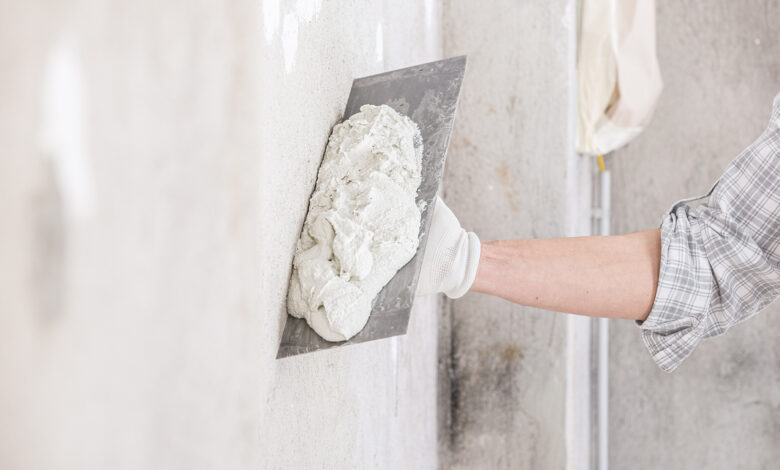What is Gypsum Plaster?

Gypsum is made out of Calcium sulfate dihydrate (CaSO4:2H20). It is generally utilized as manure, in form, in figures, and as plaster material. Gypsum is exceptionally light in weight. It is accessible in a glasslike structure in nature.
As of late, the development area has seen a few recent fads, innovation progressions, and advancements across applications, all pointed toward making development quicker and conveying better execution. Floor Screeds are applied after the application of gypsum.
Gypsum albeit a lot more seasoned material than concrete and sand plaster has seldom been utilized widely in the development business. These days, Gypsum has ended up being an extraordinary material supporting inside development because of its properties.
What is Gypsum Plaster?
Whenever the dry POP powder is blended in with water it solidifies. This material which can be applied over block, square, or substantial surface to shape a smooth surface is called gypsum plaster.
Prior, a 6 mm layer of Gypsum Plaster(named as POP punning) is normally applied on the highest point of concrete plaster to give a smooth completion to it prior to painting. This is a two-stage process and includes different components like sand, concrete, and water which must be blended nearby. This interaction is gradually being supplanted by the immediate use of a solitary layer of gypsum plaster. In gypsum plaster, the readymade POP powder is blended in with water and applied straightforwardly to the divider.
Gypsum Plaster can be applied straightforwardly on any block, strong or empty squares, AAC squares, and plasterboards. Gypsum plaster has great protection properties, is heatproof, and effect is safe. Likewise, gypsum saves a ton of time during development and has a prevalent completion. These properties have drawn the consideration of land developers and workers for hire towards picking gypsum plaster over conventional concrete plaster.
What is Plaster of Paris?
Plaster of Paris is acquired by crushing the gypsum (calcium sulfate hemihydrate CaSO4 0.5H2O) which is warmed to a temperature of 150 deg centigrade.
Endless supply of water, Plaster of Paris (POP) becomes normal gypsum (dihydrate) again making the resultant material solidify. This solidifying material can be utilized to make molds for projecting and in development.
Benefits of Gypsum Plaster
Project workers and Builders began favoring gypsum plaster rather because of its unrivaled completion and efficient traits. A portion of the benefits of gypsum plaster are:
Simplicity of Application (Workability)
Gypsum can be straightforwardly applied over block/blockwork without discrete wrapping up. It is likewise exceptionally simple to apply and even out gypsum plaster.
No Shrinkage Cracks
Gypsum response creates less hotness when contrasted with the concrete response with water. So there are fewer Shrinkage breaks in gypsum plaster when contrasted with conventional Cement Plastering.
Fast Setting Time
Gypsum sets rapidly (i.e., inside 25-30 mins). So painting could be begun 72 hours after the utilization of gypsum plaster. Tile Adhesive can be applied after plaster.
No relieving time required
Unlike Traditional Cement Plaster, Gypsum plaster needn’t bother with any restoring saving water and time during development
High Productivity
Reduces time extensively when contrasted with customary concrete plaster
Elite Performance
Excellent high strength subsequent to drying, Durable and Lightweight (Reduces dead burden on structure)
Smooth Finish
Perfectly lined, evened out, smooth dividers and wonderful right-calculated corners
Diminished Supervision
Careful quality checking is expected for concrete plaster as concrete and sand must be appropriately proportioned. Conversely, gypsum plaster doesn’t need a similar measure of value checks for application along these lines diminishing management endeavors.
Promptly accessible unrefined substances: Gypsum is promptly accessible material. Normal Sand, which is a natural substance utilized in Traditional concrete plaster, is difficult to get.
Fire-resistant
Gypsum plaster is profoundly impervious to fire
Low warm conductivity
Gypsum has low warm conductivity. This saves electrical expenses for warming and cooling rooms in a structure.
Beautifying application: It can be effortlessly applied to embellishing purposes likewise and can be formed into various shapes
Impediments of Gypsum Plaster
Gypsum plaster can’t be utilized for outside dividers since they hold clamminess. Additionally, gypsum plastering is impossible in regions that are persistently clammy like a restroom, and so on,
Gypsum plaster is costlier than customary concrete mortar plaster (concrete and sand) for a similar thickness of plaster. Be that as it may, in regions where regular/waterway sand isn’t accessible for development, concrete mortar plastering would require a 6 mm gypsum layer to complete it making concrete plaster all the more exorbitant.
The capacity of Gypsum Plaster At Site
Openness to water or dampness diminishes the setting time and strength of gypsum plaster. So gypsum must be put away appropriately.
Gypsum Plaster (POP) sacks must be put away on a raised surface (dry stage) made of blocks/lumber/concrete at the site.
The base time span of usability of Gypsum Plaster is 3-4 months from the date of assembling. Yet, assuming appropriately put away gypsum can be utilized for an exorbitant of a half year subject to temperature and stickiness.




